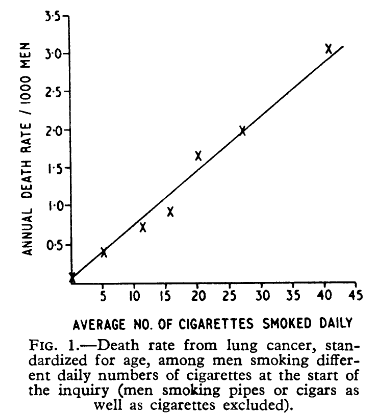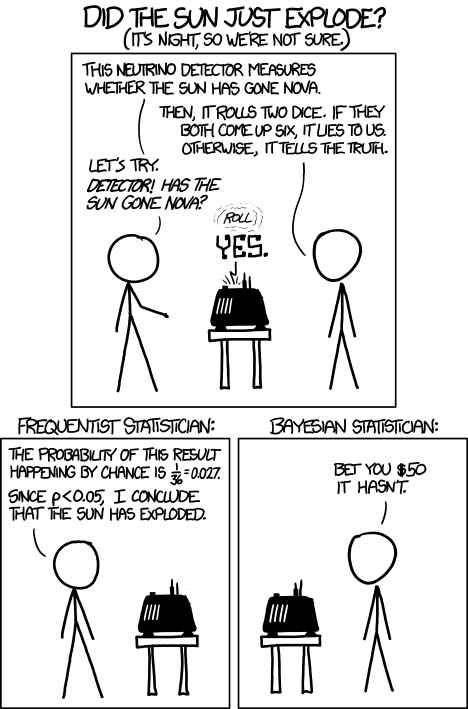
Countering Statistical Misconceptions
Types of Misconceptions
🗺️ General misconceptions about statistics
🧑🔬 🧑💼 Subject-matter expert (SME) misconceptions about statistics
🤵🕴️ Manager misconceptions
General Statistical Misconceptions
General Statistical Misconception Examples
Harvey J. Motulsky “Common Misconceptions about Data Analysis and Statistics,” Naunyn-Schmiedeberg’s Archives of Pharmacology 387, no. 11 (2014): 1017–23, https://doi.org/10.1007/s00210-014-1037-6.
Correlation => Causation
Linear regression is the only regression
Small p-value = big effect size
\(R^2\) must be \(>0.95\) to matter
Correlation and Causation
Samuel J. Gershman and Tomer D. Ullman “Causal Implicatures from Correlational Statements,” PLOS ONE 18, no. 5 (May 18, 2023): e0286067, https://doi.org/10.1371/journal.pone.0286067.
People infer causation from correlational statements, using the variable order as a directional indicator
- Even with “X is associated with an increased risk of Y” language
- Even when given the choice of non-causal interpretations, 47% of people still use causal interpretations
In summary, certain correlational statements are associated with an increased probability of causal implicature. To be clear, we are not implying that these correlational statements cause causal implicature, but rather that they are correlated with causal implicature. In other words, correlation does not imply causation, but it does sometimes “imply” causation.
Regression
📐 Engineers
- “Oh no, there’s been a huge increase in injuries! We need to do something now, before the problem gets worse!”
🤣 Statisticians

linear regression isn’t the right tool for this
have you considered other explanations?
let’s add more data…
P-values
Misconception: Small p-value => Bigger effect size
T-test between \(x_1 \sim N(0, 1)\) and \(x_2 \sim N(1, 1)\)
True \(\mu_2-\mu_1 = 1\), \(\eta = 1\)
![Two histograms showing p-values for 500 simulations of 50 samples per group, with a mean difference between groups of 0 (left) and 1 (right). On the left, the p-values are approximately uniformly distributed, with 0-10 observations for each of 100 bars. On the right, almost all observations are in the left-most bucket corresponding to [0, 0.01].](09-misconceptions_files/figure-revealjs/unnamed-chunk-3-1.png)
Under \(H_0\), p-values are uniform(0, 1) distributed!
Within each panel, the effect size is the same.
P-values
Misconception: Small p-value => Bigger effect size
T-test between \(x_1 \sim N(0, 0.5)\) and \(x_2 \sim N(0.5, 0.5)\)
True \(\mu_2-\mu_1 = 0.5\), \(\eta = 1\)
![Two histograms showing p-values for 500 simulations of 50 samples per group, with a mean difference between groups of 0 (left) and 2 (right). On the left, the p-values are approximately uniformly distributed, with 0-10 observations for each of 100 bars. On the right, all observations are in the left-most bucket corresponding to [0, 0.01].](09-misconceptions_files/figure-revealjs/unnamed-chunk-4-1.png)
R^2
As number of predictors increases in multiple regression, \(R^2\) only increases. Adjusted \(R^2\) accounts for this issue.
Good \(R^2\) are different for different fields…

R^2
\(R^2\) only measures linear relationships
Not all interesting relationships are linear

SME Misconceptions
Randomized trials are more valid than cohort or case-control studies
Study subjects must be a representative sample of the target population for generalizations to be made
Lack of statistical interaction = lack of biological interaction
Categorizing a continuous variable by percentiles is a good idea
Significance testing is the best way to report results
Randomized Trials
Randomized trials still have divergent results
random error
systematic errors (bias) - undercounting, missing data, non-adherence (e.g. medical studies)
Well-controlled cohort studies have some advantages:
age control
time since diagnosis of a condition may be better controlled
Simpson’s paradox can explain a lot of these issues!
Simpson’s Paradox
Kidney stone treatment experiment: Treatments A and B. Recorded stone size (large, small) and outcome of the treatment (success, failure).

Failure to account for moderating variables can lead to the opposite (wrong) conclusion!
Make sure your model uses the available data
Representative Samples
The British Doctors Study, which began in 1951, was the world’s first large prospective study of the effects of smoking to establish a convincing linkage between tobacco smoking and cause-specific mortality, and demonstrated prospectively the risk of death from lung cancer (1954) and myocardial infarction and chronic obstructive pulmonary disease (1956).
In October 1951, Sir Richard Doll and Sir Austin Bradford Hill sent a questionnaire on smoking habits to all registered British doctors. Of the 59600 questionnaires mailed, 41024 replies were received and 40701 (34494 males and 6207 females) were sufficiently complete to be included in the follow-up. Because of the limited sample size and limited tobacco consumption females were excluded from most reports, and the study has focused on the males. Source
Is this a representative sample of the population of
- British doctors?
- British men who are well educated?
- British men?
- Men of all nations?
- All people?
Representative Samples
1954
1964

Representative Samples
Scientific generalization vs. Statistical generalization
Science goal: Make correct statements about the way nature works
Statistics goal: Extrapolate from a sample to the source population
These goals may align, but they may not!
Whether a sample is representative enough to generalize beyond the sample population is determined by your argument.
Representative Samples
\[\left(\begin{array}{c}\text{limiting confounding variables}\\ \text{non-representative population}\end{array}\right) \overset{?}{\geq}\left(\begin{array}{c} \text{no control over confounds}\\\text{representative population}\end{array}\right)\]
The best case for generalizing results is if there are
consensus findings
from studies using different designs
across different populations
by different research groups.
Interaction Interpretation
Misconception: Lack of statistical interaction => lack of real-world interaction
Statistical interaction effects are conditional on the specific model and data
Model lack of fit => interaction may not be significant even if real-world effect exists
Data collected over wrong range?
All models are wrong, but some are useful – George Box
Significance Testing

‘Detector! What would the Bayesian statistician say if I asked him whether the–’ [roll] ‘I AM A NEUTRINO DETECTOR, NOT A LABYRINTH GUARD. SERIOUSLY, DID YOUR BRAIN FALL OUT?’ [roll] ‘… yes.’
The null is MUCH MORE LIKELY than the alternative!
Significance Testing
Null Hypothesis Significance Testing (NHST) is a combination of two distinct testing philosophies (More Reading)
It is often more important is to understand the size of the effect
Confidence intervals provide both effect size and precision!
- (and don’t have to be reduced to is the null value in here?)
Assess both statistical significance and practical significance when assessing and interpreting results
Manager Misconceptions
Manager Misconception Examples
Just rerun the experiment with a bigger sample size!
Statisticians can predict exactly what will happen next 🔮🪄🧙

Address these issues in person if at all possible. Try not to laugh or cry.
